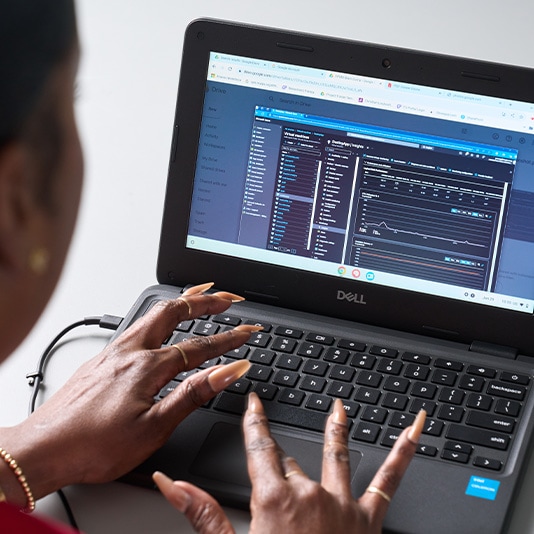March 28, 2025
Why Partnership Is Key to Moving K–12 to the Cloud
CDW makes cloud migration seamless for a Midwestern district.

In my work coordinating technology advisory services for K–12 districts, I often meet with IT leaders who’d like to know how they can migrate to the cloud. Their goal is to transfer data and applications from on-premises infrastructure to a cloud-computing service hosted by a third party.
A great recent example is Indianapolis Public Schools. The district had been running its own data center in an aging building, and the IT team was struggling with expensive upgrades and time-intensive maintenance. They had already switched many of their apps from on-premises to Software as a Service. But they still had a large number of virtual machines on their aging infrastructure, and they did not want to refresh the servers and put off modernization for another five years.
Furthermore, IPS’s leaders were looking forward to adopting technologies such as artificial intelligence, which they knew would require serious computing power. The district also had monies from the Elementary and Secondary School Emergency Relief Funds available to use for modernization, but they were going to expire in a year. The writing was on the wall: IPS needed to modernize now, and cloud migration was the answer.
However, moving to the cloud is no easy feat, and because most schools do not have onsite expertise in this technology, it was essential to get support from an experienced cloud partner, so the district requested our help. Here is the framework and services we used to help IPS leave its old data center behind.
Make a Plan for Local and Cloud Apps
Some districts assume that all applications can be moved off-premises and to the cloud. In reality, most are ready to go, but some will function only in a local environment, some can move only if other apps go with them, and some could function in the cloud but the app vendor may not support that option. At IPS, we ultimately determined that 95% of the district’s apps could successfully make the shift.
We did so by offering services that helped with discovery and assessment, app dependency mapping and placement, and cloud strategy development. We evaluated each app’s security and backup needs to bolster user privacy and data protection, and we helped the district’s IT leaders understand exactly what the migration would entail. We also helped them plan for the minimal infrastructure their district would require for those applications that could not make the move to cloud.


Develop a Budget for One-Time and Ongoing Costs
By reducing their need for infrastructure, many districts see significant savings related to server upkeep. Still, migration itself can be expensive, and there are recurring costs associated with operating cloud-hosted systems.
At IPS, we evaluated the financial implications of the migration and developed a budget tailored to the district’s needs. We also identified funding opportunities from state, federal and other resources.
Because we had to create the budget before we did any of the consulting services, we were not sure how many of the applications could move to cloud. This made budgeting difficult, but we found a solution. We looked at several scenarios and created a financial model for each:
- Everything migrates to a colocation provider.
- One-third of the apps migrate to cloud.
- Two-thirds of the apps migrate to cloud.
- Everything migrates to cloud.
Then we used the highest and lowest numbers to create a budget window that IPS could refer to when communicating with the board and getting budget approval.
Minimize Disruptions by Migrating Apps in Waves
While migration to the cloud is typically straightforward, to avoid possible disruptions to learning, most districts make the move when school is out. For IPS, this was over the summer of 2024, before the start of fall semester.
We conducted the app migrations in waves, and we coordinated each shift with user acceptance testing to ensure the school community was happy with the results. In the first waves, we moved apps that were easy to migrate, creating positive momentum among the district’s IT operations staff and end users.
If an app failed to migrate, we kept it on-premises, identified the migration problem, found a solution, applied the solution and then put that app in a future migration wave. This allowed us to keep app disruptions to a minimum while we continued to make progress.
Fill Knowledge Gaps With Cloud Training and Temporary Staffing
It’s helpful for IT staff to understand how app management in the cloud environment differs from what they’re accustomed to on-premises. For IPS, we accomplished this by training the IT operations team in both cloud administration and automation. We also staffed an experienced cloud admin on a short-term basis to mentor their IT operations team in cloud administration, support and troubleshooting, and help with the transition to cloud during the migration.
Optimize Cloud Management With Ongoing Support
Once a district is established in the cloud, it must ensure efficient management of cloud resources. IPS took advantage of CDW’s Cloud Solution Provider Program to receive first-line support for any outages or other customer service issues, and for free access to our Inscape Cloud Management tool for monitoring costs and optimizing resource usage.
The cloud migration process is complicated enough. Having a trusted partner like CDW can help make the process smoother.
Jeremy Wonson
Enterprise Architect


